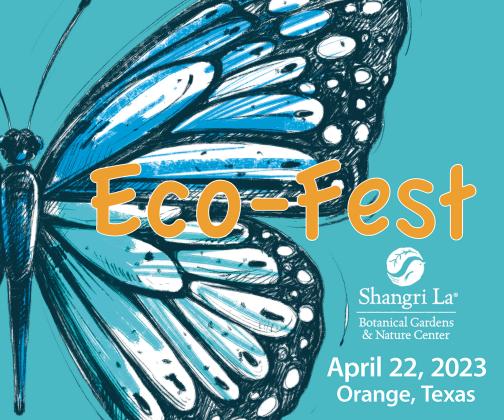Each year in April, Shangri La Botanical Gardens and Nature Center celebrates Earth Day with an Eco-Fest and butterfly release. The community is invited to attend the free celebration that signifies what Shangri La Gardens is all about Saturday, April 22, which is actually Earth Day, from 10 a.m. to 3:30 p.m. culminating with three inspirational butterfly releases at 11 a.m., 1 p.m. and 3 p.m.
The day will be filled with family fun that highlights sustainability and natural history. Local and regional organizations and business will be onsite-hosting booths that provide information about earth-friendly products, services as well as vendors selling different products such as vegetables, goat milk soaps and much more. Games, activities, and engaging presentations provide entertainment for the entire family.
“Butterflies are incredibly importantly,” said Katie Krantz, assistant executive director of Shangri La. “If fruit or vegetables are involved, you have to have pollinators in order to produce them and butterflies are our main pollinators.”
Approximately 1,500 Painted Lady butterflies will be released at Eco Fest.
“The butterflies are just spectacular,” said Krantz. “We release the Painted Lady and they are native to Southeast Texas, so we wanted to make sure we are releasing butterflies that you would find here naturally.”
The Painted Lady is one of the most familiar butterflies in the world, found on nearly all continents and climates. They are also called the “thistle butterfly” because thistle plants are its favorite nectar plant for food as well as the “cosmopolitan butterfly” because of its global distribution. These medium-sized butterflies can cover a lot of ground, up to 100 miles per day during their migrations. A Painted Lady is capable of reaching a speed of nearly 30 miles per hour.
They do not sting or bite, are brightly colored, is why people enjoy seeing them fly around. For the plant world, butterflies pollinate or carry pollen from plant to plant, helping fruits, vegetables, and flowers to produce new seeds. An abundance of butterflies is often an indication that an ecosystem is thriving.
Many native flowers are not pollinated by bees so only butterflies with their long proboscis can reach into the flower blossom deep enough to pollinate these species. Bees are generally restricted to local areas where as butterflies are always on the move and can cross-pollinate over a large area improving the genetic mix of genes of the plant community.
“My favorite part of the day is watching kids release the butterflies,” said Krantz. “Just the sheer joy of the experience is so memorable. Everyone gets so excited. It’s nice for us to be able to provide that.”
What exactly is Earth Day? Earth Day marks the anniversary of the birth of the modern environmental movement in 1970 when Sen. Gaylord Nelson, from Wisconsin, had long been concerned about the deteriorating environment in the United States. After witnessing a massive oil spill in Santa Barbara, California, Nelson wanted to infuse the energy of students with an emerging public consciousness about air and water pollution. He announced the idea for a teach-in on college campuses to the national media, and persuaded Pete McCloskey, a conservation-minded Republican Congressman, to serve as his co-chair. They recruited Denis Hayes, a young activist, to organize the campus teach-ins and they choose April 22, a weekday falling between Spring Break and Final Exams, to maximize the greatest student participation.
Earth Day went global in 1990 by mobilizing 200 million people in 141 countries and lifting environmental issues onto the world stage.
Fast forward to 2023 – Earth Day is widely recognized as the largest secular observance in the world, marked by more than a billion people every year as a day of action to change human behavior and create global, national and local policy changes.
“This is a perfect time to come to Shangri La,” said Krantz. “We want to inspire and mentor children of all ages to be kind to their world while experiencing new and fun things in nature.
There are beautiful flowers in bloom such as native plants of Texas, tropical and semi-tropical plants. You can see birds nesting on Ruby Lake and even alligators sunning. If you want to experience our local swamps, you can do so on our ponton boat. Even if you aren’t a plant person, this is a great opportunity to be outside.”
Located at 2111 West Park Ave. on 252 acres in Orange, Shangri La is a combination of botanical gardens and an eco-friendly nature center that features more than 300 plant species, outpost tours along Adams Bayou, seasonal nesting birds seen from our state-of-the-art bird blind and heronry, and up-close encounters with nature during classes, camps, lectures, educational programs and much more for all ages.
For more information, visit shangrilagardens.org or call (409) 670-9113.
-Chad Cooper, Entertainment Editor







